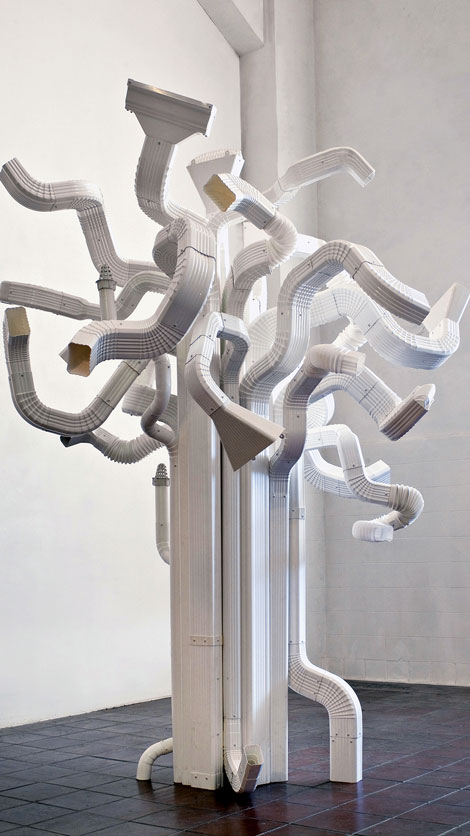The art of Lynn Aldrich celebrates and extrapolates on the ordinary. She focuses on objects from the world of everyday life to both transform them structurally and insinuate a sense of larger mysteries. She takes utensils and garden-variety household items and through both imaginative additions and deviations from function turns them into vehicles of greater significance. Aldrich veers into the transcendental without any irony and draws out the quotidian into an expansive field of multiple meanings.
While some artists transform found objects through more theatrical arrangements, Aldrich stays close to her source. She wants to reference the object as something we use (and often it is in direct relationship to a woman’s work in the household) as well as look for epiphanies in the ordinary. She is interested in how commonplace things and situations contain the potential for transcendence, and thus she sets her art apart from both the formal bent of minimalism and the self-reflexive penchant of appropriation.
This survey gives an important overview of her work and allows a viewer to follow more closely how she revisits ideas and materials and to judge how well she resolves her puzzles.
With Silver Lining (2009-2013) a substantial group of shiny metal rain gutters are suspended at different heights in the gallery entryway. They appear poised between descending and rising, and a variety of tones of blue are visible in the ends just above the viewer’s head. It is as if water-colored lighting were being poured into the gallery from above. The humor in the title is also characteristic of Aldrich’s work: turning a lowly gutter into a passageway for color and therefore light.
In Breaker (1999), a burst of garden hoses and brass couplings rise from the ground like a wave, and the sense of tidal shifts being channeled through these plastic tubes is unmistakable. At the same time, a viewer becomes acutely aware of the different hues of green or blue-green and the variety of patterned woven strands that constitute the overlooked qualities of things we see mostly in the backyard. From a means for simply delivering water to plants, her hoses become a mode for rethinking the act of bringing water and sustenance to another living entity.
Nowhere is her sense of restraint and compositional clarity more visible than in Ray (2005). This slanting column formed by 150 colors of sewing thread tautly strung between the ceiling and collected into a super glue and transparent tape ellipse on the floor is both beautiful and beguiling. Its poetics stretch from the unorthodox use of sewing materials to the magical optical effect that these minute strands of color create in the light.
Magisterial and, paradoxically, quite modest, the aggregations of Lynn Aldrich add up to a world in which the everyday stuff we take for granted takes on unexpected philosophical dimensions.


